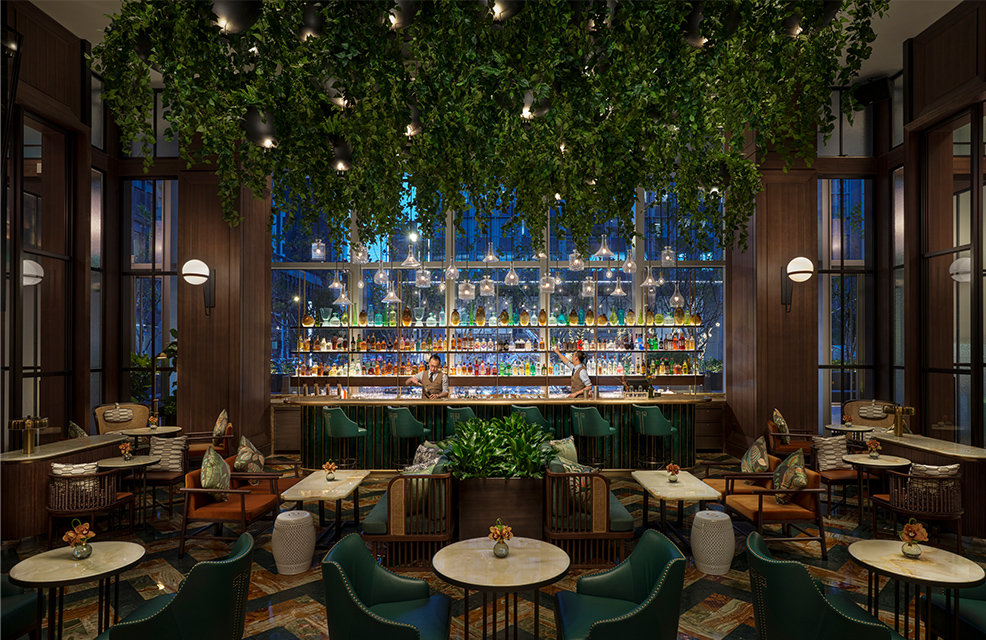
Shangri-La Qiantan Shanghai
scroll
Forward-thinking whilst embracing the heritage of Harrods
2021 Winner Surfaces and Finishes, Shop fitting/Fit Out
2021 Winner Retail Design
In the early 1900's, wealthy families eschewed the term 'mansion', instead opting to refer to their homes as the 'big' or 'great house'. Despite the unassuming terminology that modern etiquette dictated, these Great Houses were typified by luxurious appointments and furnishings alongside great retinues of indoor and outdoor staff, sometimes outnumbering residents by as much as ten to one.
The intention for the new Harrods Beauty Hall was to create a modern distillation of a Great House, from a bygone era where service was personal and every need was catered for; to provide a sanctuary to escape from the stresses and pace of city life, a haven for pleasure and relaxation.
Most Great Houses were composed of many intimate common and reception rooms where guests would be entertained, and private rooms and suites where the family could retreat from the eyes of both visitors and staff. The challenge was to recreate this idea whilst remaining true to the heritage of the building where the new Beauty Hall now lives once stood one of the first examples of an open-plan retail space in the UK It was important that the history of the space informed the new design and so this openness has been retained through the use of fine, satin-nickel trim, cut-glass and marble, to create a semi-tranparent framework of the essence of a home; a delicate tracery of a house as if an after-image retained in the memory of the grand architecture.
Image by Tony FIsher
Sunburst veining in the marble is a nod to the Roaring Twenties and forms another layer of narrative. During this period of prosperity and social opportunity, the Basil Street block of Harrods, in which the Beauty Hall sits, was rebuilt by Louis D. Blanc in a restrained, yet sleek Art Deco style. Ceilings and columns have been retained whilst the popular geometric designs and floral motifs of this era have been subtly woven into the detailing of the new design. Salvaged ceiling lights discovered in the Harrods archive have been sensitively replicated and now adorn the vaulted ceilings of the galleries that flank the vestibule.
Image by Tony FIsher
Once inside, customers will find a a tale of two halves, with an emporium of make-up brands to one side and a less formal arrangement of lifestyle and sunglasses brands to the other.
Central to the make-up area the layout becomes more relaxed with different volumes being utilised to create a serene space where shoppers can browse products displayed on 'bookcases' alongside a mixture of frosted and transparent books with integrated lighting; a fun feature that helps reinforce the Great House theme.
Images by Tony FIsher
Images by Tony FIsher
No Great House would be complete without a grand staircase, and so customers will be led to the new Beauty Services Suites past walls clad in bronze flutes before descending stairs built in sumptuous Golden Spider marble with brass inlay. Beneath, the Acanthus motif taken from the heritage columns has been reinterpreted as a striking floor pattern. Suspended over the double height ceiling hangs a contemporary interpretation of a chandelier made up of six pairs of back-to-back digital screens which will live stream masterclasses taking place in the Beauty Service Suites. This floor also houses a collection of private treatment rooms, decorated in soothing tones of blush with ribbed timber panelling and marble architraves.
Image by Tony FIsher
Images by Tony FIsher
The skincare emporium
The second phase of the Beauty Hall renovation, dedicated entirely to luxury skincare ranges, is at the heart of the ‘Great House’ and has been reimagined as a glasshouse organgery within a private walled courtyard. A fresh and light palette with new Terazzo flooring and heritage inspired architectural detailing complements the Beauty Hall scheme and provides a dramatic contrast to the moodier fresh food hall, adjacent.
Image by Tony FIsher
Images by Tony FIsher
Images by Tony FIsher
Images by Tony FIsher
An underground beauty wonderland
Images by Tony FIsher
Colour and skincare masterclasses
Images by Tony FIsher












